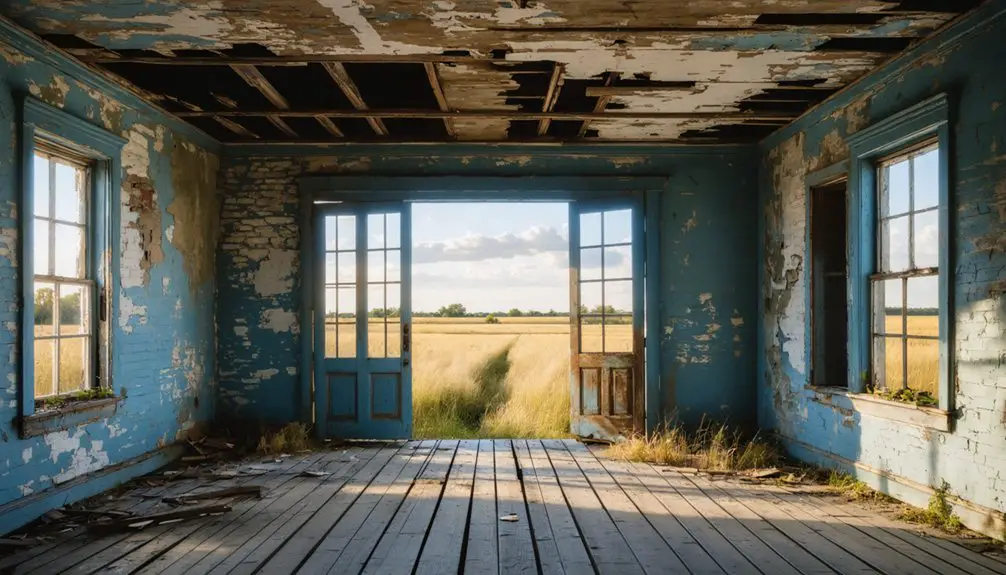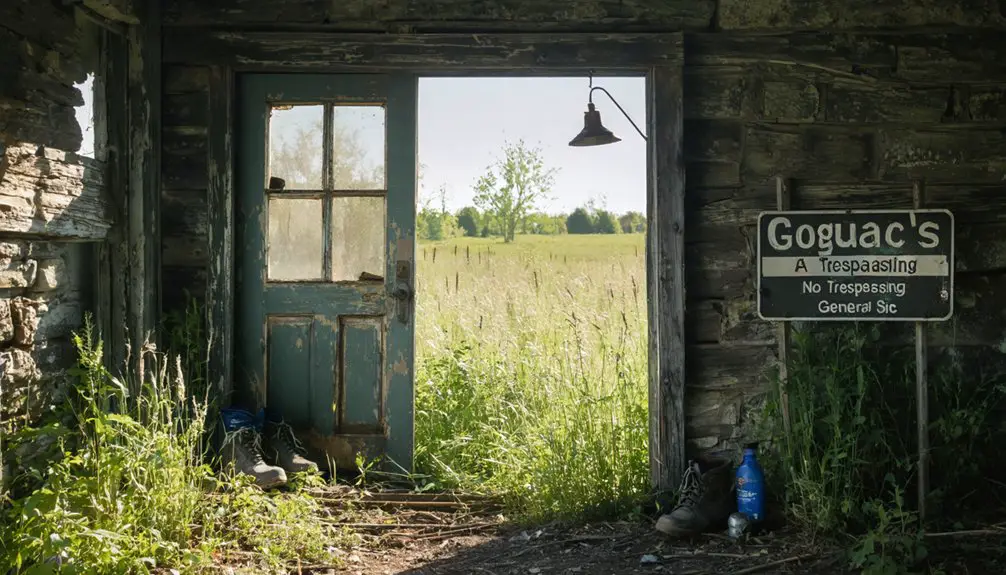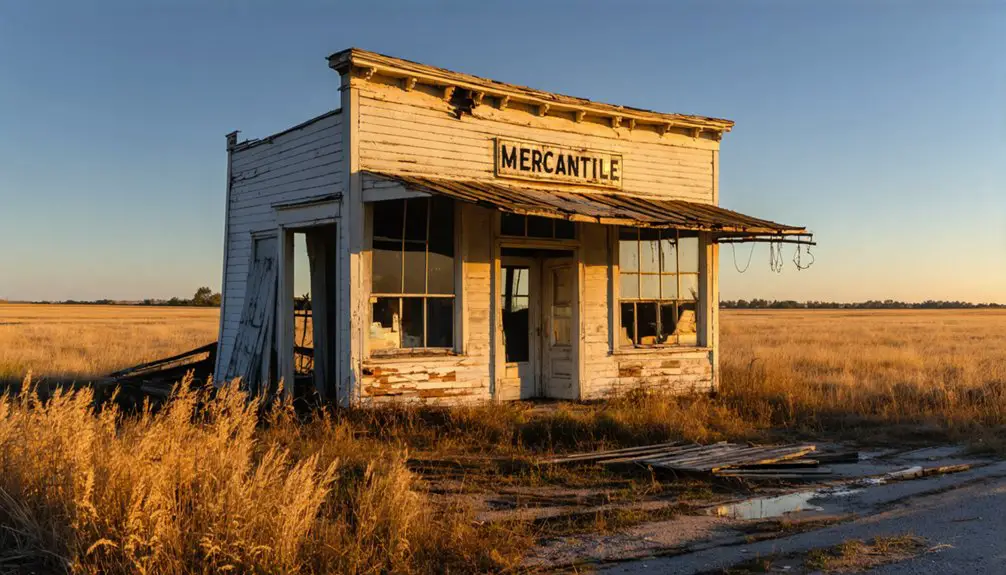You’ll find Goguac nestled in northwestern Logan County, Kansas, at an elevation of 3,113 feet along the North Fork of the Smoky Hill River. This once-thriving 1850s settlement featured a bustling main street, New Deal-era City Hall, and Methodist church during its peak. The town declined after local mine closures and changing railroad routes drove residents away. Today, foundation stones and ghost roads dot the Kansas farmland, while local historical societies preserve Goguac’s compelling frontier story.
Key Takeaways
- Goguac was established in northwestern Logan County, Kansas during the 1850s, thriving initially due to farming and railroad connections.
- The town reached its peak in the late 1800s with several hundred residents, supported by agriculture and local businesses.
- Economic decline began when local coal mines closed in the early 1900s, leading to population loss and eventual abandonment.
- Notable remnants include a 1936 New Deal City Hall, brick Methodist church, and water tower along Chestnut Street.
- Today, most of Goguac lies beneath Kansas farmland, with only ghost roads and foundation stones marking its former location.
Early Settlement and Historical Roots
When settlers first arrived in Goguac during the mid-1850s, they encountered a landscape that would shape Kansas’s territorial expansion.
You’ll find that early settlement patterns followed indigenous influences, as newcomers often relied on Native American trails and knowledge to establish their homes and trading posts.
The town’s name reflects the era’s common practice of adopting Native American words, likely drawing from Osage heritage.
Like many Kansas settlements that emerged after the Kansas-Nebraska Act of 1854, Goguac started as a small cluster of determined pioneers seeking land and opportunity.
These early residents faced the region’s harsh realities while building their community amid the tensions of Bleeding Kansas, working to establish essential services like post offices and schools that would determine their town’s fate.
The first U.S. District Court proceedings in the area were conducted in 1856, marking a significant step in establishing formal governance structures.
Similar to the residents of Brooks, many settlers were forced to evacuate to Missouri due to increasing violence between pro-slavery and free-state factions.
Geographic Location and Natural Features
Three distinctive features mark Goguac’s location in northwestern Logan County, Kansas: its position along the North Fork of the Smoky Hill River, its elevation of 3,113 feet above sea level, and its proximity to the twin Consolation Points buttes.
You’ll find the town situated at 39.02°N latitude and 101.36°W longitude, about a mile northeast of present-day McAllaster.
The town’s landform characteristics reflect its High Plains heritage, with the settlement strategically positioned on a ravine’s side for natural drainage. Similar to Columbia’s early settlers who faced uncertainty with land claims, Goguac’s pioneers initially struggled to establish clear property boundaries. The area’s geological composition mirrors the innovative designs found in early American automobile engineering of the 1920s.
At the base of the Consolation Points, you’ll discover Lake Como, a water-filled depression that served as a crucial water source for early settlers.
The surrounding semi-arid grasslands and deep, fertile soils paint a picture of the challenging yet promising environment that drew pioneers to this frontier outpost.
Economic Rise and Peak Development
Like many frontier settlements of the 1880s, Goguac’s economic foundation rested on small-scale farming operations and the promise of railroad connectivity.
Frontier towns like Goguac built their dreams on fertile soil and iron rails, hoping to transform wilderness into prosperity.
You’d have seen local farmers implementing economic diversification strategies, growing various crops while maintaining livestock to hedge against market demand fluctuations. The rise of technology allowed farmers to manage increasingly larger tracts of land. The town’s merchants established general stores and trading posts, creating a modest but essential commercial hub for the surrounding agricultural community. Similar to the Kansas City Pittsburgh and Gulf Railroad’s impact on shipping points like Asbury, the railway enhanced local commerce.
When the railway plans materialized, Goguac experienced a brief surge in development. New buildings rose along the main street, and you’d have witnessed the bustling activity of grain elevators during harvest season.
The town’s peak coincided with the region’s agricultural boom, as favorable market conditions and technological improvements in farming methods brought prosperity to many of Goguac’s residents.
The People of Goguac
During Goguac’s peak years, you’d find farmers tending wheat fields alongside merchants running the general store and blacksmiths working their forges, while prominent citizens like the postmaster and church leaders shaped community decisions.
The town’s population swelled to several hundred residents by the late 1800s, including a notable presence of African American settlers who established farms and businesses in the area. Natural disasters like severe droughts and destructive grasshopper invasions devastated many local farming operations.
Life centered around the town’s gathering spots, where you’d see families at church socials, children at the schoolhouse, and neighbors trading news at the post office. Like many settlements in Greenwood County that experienced population decline, Goguac eventually lost most of its residents.
Daily Life and Work
While mining operations drove Goguac’s economy in its early years, the town’s workforce embraced diverse roles that shaped daily life in this Kansas settlement.
You’d find miners heading to the lead and zinc mines at dawn, while farmers and ranchers tended their lands as agriculture gained prominence. Local businesses, from general stores to barber shops doubling as dry cleaners, kept the community running. Like Empire City’s 3,000 residents, Goguac’s population thrived during the peak mining years. Economic depressions and technological farm advances gradually reduced the need for agricultural workers in the region.
Social gatherings centered around the town’s churches and saloons, where work routines gave way to evening entertainment.
You might’ve found yourself choosing between four different churches on Sunday morning, or joining the crowd at the local saloon come nightfall.
Without much law enforcement, these gatherings could turn rowdy, especially after dark when the gambling halls came alive.
Notable Community Leaders
As Goguac evolved from a mining outpost into a bustling frontier town, its leadership emerged from diverse backgrounds to shape the community’s destiny.
You’ll find historical figures like Peter, who first named it Centennial City, and the influential West Joplain Lead and Zinc Company executives who transformed it into a company town.
Community leadership extended beyond mining interests. The town’s schoolmaster presided over education while religious leaders managed four churches that became social anchors.
Without formal police, sheriffs and marshals struggled to maintain order, particularly during events like the 1884 Honeywell gunfight.
You’ll discover that these leaders balanced the town’s wild nature – its saloons, gambling halls, and brothels – with attempts to create stability through infrastructure development and dispute resolution in the courts.
Population Through Time
The population story of Goguac mirrors the rise and fall of many Kansas mining towns. Like its neighbors, the town experienced dramatic population shifts during the mining boom of the late 1800s, when hundreds of residents called it home.
You’d have found a bustling community centered around coal extraction, complete with the standard fixtures of frontier life – general stores, churches, and schools.
As mining operations began to decline in the early 1900s, Goguac’s demographic trends followed the familiar pattern of Kansas ghost towns. When cheaper resources were discovered elsewhere and mining jobs disappeared, families moved away in waves.
The closure of essential services like the post office and school marked turning points in the town’s decline. Today, you’ll find only scattered remnants of Goguac’s once-thriving population, with just a handful of residents maintaining ties to this historic mining community.
Factors Leading to Town’s Decline
During the early twentieth century, multiple factors converged to seal Goguac’s fate as a ghost town. Economic factors hit hardest when the local coal mines shut down after cheaper deposits were found elsewhere in Kansas.
The mine closures in early 1900s Kansas struck a devastating blow to Goguac, setting the small town on an irreversible path to abandonment.
Transportation issues mounted as railroad routes changed, cutting off crucial supply lines and trade connections.
Demographic changes accelerated as younger residents moved to larger cities seeking better opportunities, while environmental challenges from tornadoes and floods damaged buildings beyond repair.
The town’s community resilience weakened under mounting competition dynamics from nearby urban centers, which offered superior amenities and jobs.
As mechanization reduced farm labor needs and businesses relocated, Goguac couldn’t maintain its population. Without a strong economic base or convenient access, the town gradually lost its ability to sustain itself.
Notable Buildings and Infrastructure

Notable structures scattered throughout Goguac paint a vivid picture of this once-thriving Kansas community.
You’ll find the 1936 New Deal-era City Hall, built with dressed stone, standing proudly on Chestnut Street. The brick Elmdale United Methodist Church, dating between 1890-1917, remains a symbol of historic preservation at Spruce and Elm. A distinctive water tower dominates the skyline, while the town’s architectural significance shines through its brick auditorium with its carved parapet stone.
The active post office, modern brick construction with ZIP code 66850, continues serving residents west of Main and Chestnut.
You’ll also discover remnants of the town’s past in its converted spaces, like the old store foundation that’s now a basketball court, and a two-story rock schoolhouse that’s been transformed into a residence.
Cultural Legacy and Historical Significance
Situated along the historic Oregon Trail, Goguac’s cultural legacy mirrors the rise and fall of countless Kansas railroad towns during America’s westward expansion.
You’ll find the town’s story deeply woven into regional folklore traditions, particularly through tales of limestone quarrymen and railroad workers who shaped its identity in the 1880s.
The community’s cultural preservation efforts highlight how working-class values and industrial labor united residents around shared experiences.
Hard work and shared labor forged deep community bonds, bringing together diverse residents through common purpose and collective identity.
In local halls and outdoor gathering spots, you’d have witnessed the tight-knit social fabric that defined small-town Kansas life.
Though Goguac’s physical presence has faded, its historical significance endures as a reflection of the boom-and-bust cycle that characterized the American frontier, offering valuable insights into the economic and social transformations that reshaped rural Kansas.
Present-Day Remnants and Tourism

While traces of Goguac’s past have largely disappeared beneath Kansas farmland, you’ll find subtle hints of the former settlement through faint outlines of grass-covered “ghost” roads and scattered foundation stones.
Your ghost town exploration will take you down unpaved rural routes, where agricultural impact has transformed the once-bustling community into quiet fields.
- Access the site via local farm roads, though you won’t find dedicated visitor facilities
- Look for historical markers or county records to guide your visit
- Bring historical photographs to compare past and present landscapes
- Document your findings with modern technology like drone photography
For the most rewarding experience, connect with local historical societies who maintain archives of Goguac’s story.
Their records can help you piece together the town’s layout despite minimal physical remnants on site.
Frequently Asked Questions
Were There Any Famous Outlaws or Gunfights in Goguac’s History?
You won’t find records of famous Goguac outlaws or Goguac gunfights in historical documents. While the town had its share of mining-era disorder, no legendary criminals or shootouts were specifically documented.
What Native American Tribes Originally Inhabited the Goguac Area?
You’ll find the Kanza, Osage, Pawnee, and Comanche tribes originally inhabited this area, with their tribal history deeply connected to buffalo hunting and cultural significance along the Kansas River valleys.
Did Any Paranormal Activity or Ghost Stories Originate From Goguac?
You won’t find documented ghost sightings or paranormal investigations from Goguac. Unlike other Kansas ghost towns with rich supernatural folklore, there aren’t any verified reports of haunting activity from this former mining community.
What Was the Average Property Value in Goguac During Its Peak?
You won’t find specific property values due to limited historical records, but like other Kansas towns, property trends followed economic factors such as agricultural success and transportation development during peak periods.
Were Any Movies or Television Shows Ever Filmed in Goguac?
You won’t find any recorded Goguac films or Goguac shows in historical records. There’s no evidence that any movies or television productions ever used this ghost town as a filming location.
References
- https://www.hhhistory.com/2019/05/ghost-towns-of-kansas.html
- https://www.youtube.com/watch?v=VPZtNoncnig
- https://legendsofkansas.com/kansas-ghost-town-list/
- https://www.youtube.com/watch?v=alC1wDdSVvg
- https://www.youtube.com/watch?v=OyBXD18P_j4
- https://en.wikipedia.org/wiki/Cofachique
- https://www.youtube.com/watch?v=8imf9ZEYVSA
- https://www.youtube.com/watch?v=iB5rHT14eVI
- https://en.wikipedia.org/wiki/Sheridan
- https://dianastaresinicdeane.wordpress.com/2012/01/29/columbia-a-kansas-ghost-town-story/



